Alan Packer said, “We can do hard things—it’s the impossible that takes a little longer.” Well, we have been doing hard things for quite a while now. In fact, it seems that we are in the ‘impossible’ phase now. Truly, I believe we have been working on accomplishing the “impossible” for quite some time now, aided by resilience.
Who are WE?
‘We’ are made up of health care workers, direct and indirect care workers in long term care. ‘We’ also includes essential workers in service industries, people who have lost their jobs or are currently furloughed, and those who are balancing work and family responsibilities.
The ‘we’ also includes all of us when we wear masks, wash our hands repeatedly, and remain socially distant. ‘We’ are making sacrifices.
To be honest, some of us are definitely being called to make more sacrifices than others. People working in nursing homes, assisted living, hospitals and hospice, to name a few. Not only are they giving it their all at work, they also sacrifice time with family and interactions with loved ones.
How do they do it?
Keeping up and keeping on is one of those hard things. One of the ways to keep on keeping on is through resilience.
What is resilience?
Resilience is the capability to spring back into action, to recover quickly after adversity. In physics, Merriam Webster defines resilience as ‘the ability of an elastic material (such as rubber or animal tissue) to absorb energy (such as from a blow) and release that energy as it springs back to its original shape.” If that doesn’t describe essential workers, especially those in the health care and long term care industries, I don’t know what does.
How to Build Resilience
You can’t give energy after something happens if you have no energy to spare. Self care goes a long way in helping to build resilience.
Having some control in your environment also contributes to maintaining resilience. Genetics and engaging in healthy habits play a role in building resilience. The National Alliance on Mental Illness has additional suggestions and ideas on resilience.
In the meantime, thank you to those still fully engaged in caring for the mental and physical health of others. Please keep on doing the hard things. “We” appreciate you.
Kathy Dreyer, Ph.D., is an Advisor at AGE-u-cate® Training Institute, which develops and delivers innovative research-based aging and dementia training programs such as Dementia Live® and Compassionate Touch®, for professional and family caregivers; kathy.dreyer@ageucate.com



